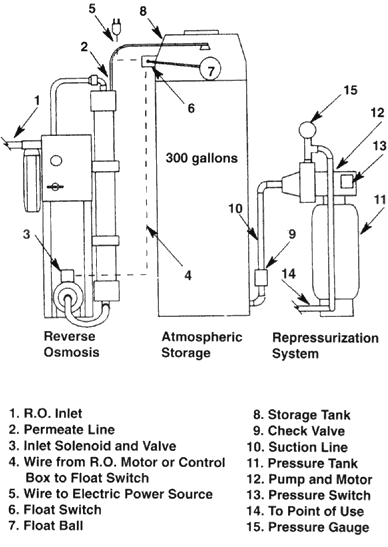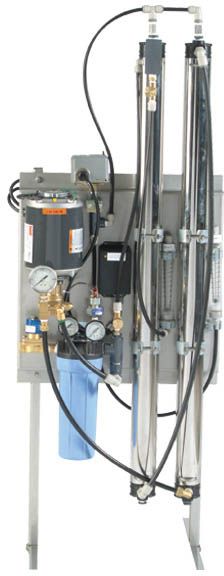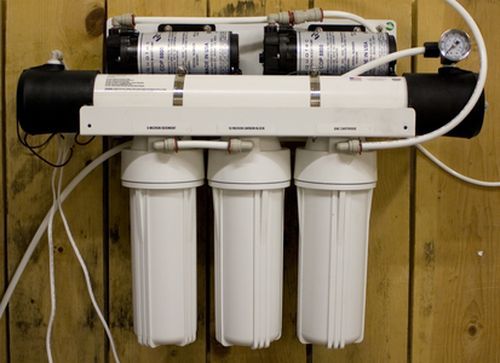Special Mid-Month Issue August 15, 2011 |
|---|
Whole House Reverse Osmosis
Reverse osmosis is a familiar item in many homes, but it is usually the small undersink drinking water systems that people are acquainted with. These are usually called "point of use" units.
Larger RO units that treat all the water going into a home or building are known as "point of entry" systems, and they are commonly called "whole house" RO units.
Reverse osmosis is not a practical "whole house" treatment option for most residential situations. Most city water can be treated more easily and with far less expense by simple filtration or softening. But for certain difficult waters, whole house reverse osmosis is sometimes not only the best solution, it is virtually the only solution.
The most common application for large, point-of-entry reverse osmosis is water with high salt content. Reverse osmosis effectively removes sodium, chloride, fluoride and other difficult-to-treat contaminants.
Reverse osmosis has unique properties and solves problems that are often impossible for conventional filters. For a good list of percentage rejection figures for various contaminants, go here. Keep in mind that the list gives expected figures for small drinking water units, and the high pressure units described here usually perform a few percentage points better. Keep in mind, too, that carbon filtration is almost always used in conjunction with whole house reverse osmosis units and the carbon/reverse osmosis combination adds virtually all chemical contaminants to the list of items reduced.
How It Works
Let's start with a picture of a typical whole house treatment array.
 |
|---|
Large reverse osmosis units work on many of the same principles as small undersink reverse osmosis units, but they have some distinctive features.
The unit above is what might be called a "whole house" reverse osmosis unit--one that is suitable in size and performance to supply very high quality water for an entire residence.
The distinguishing features are the ability to produce a significant amount of water--several hundred gallons per day--and the ability to handle water that is very high in total dissolved solids (TDS). High operating pressures make that possible.
The picture shows the three distinctive parts of the whole house reverse osmosis unit. On the left is the RO unit itself, which produces the water. In the center is the storage tank. Since reverse osmosis seldom makes water fast enough for the demands of the home, a storage tank is provided so that water can be stored to be available upon demand. The storage tank is normally an "atmospheric tank." This means that it is not pressurized, so for water to be delivered to the residence it must go through a pump to repressurize it. Therefore, the final part of the system, on the right in the picture, is the repressurization system. The repressurization system sends the water from the tank under pressure to the point of use.
Here are more details:
1. The RO Unit itself. Water enters the unit at #1, passes through a sediment filter and is picked up by the pump, which sends it under high pressure to the RO membrane--the tall vertical cylinder. Part of the water is forced through the semi-permeably membrane--so tight that it "rejects" almost everything that isn't pure water, including even the mineral content of the water. The greater part of the water, however, leaves the membrane housing as drain water. The drain water washes away the rejected impurities and the product water passes on to the storage tank.
The reject water is called brine and the product water is called permeate.
In most large reverse osmosis units part of the brine is recycled into the inlet stream and sent back for a second pass through the membrane. Furthermore, on high production RO units with more than one membrane, the brine from membrane #1 is used to feed membrane #2, so multi-membrane systems are more efficient than single membrane units.
In the twin-membrane Watts 1200 gallon per day RO unit shown below, the reject water from one membrane becomes the feed water for the other.
 |
|---|
2. The Storage Tank. Filling of the atmospheric storage tank is controlled by a float valve (#6 and #7). When the tank is full of permeate water, a switch turns off the unit and production stops. When water is used from the tank and and the water level falls a few inches below the top of the tank, the float switch starts the unit again and the tank is filled.
3. Repressurization. Water leaves the atmospheric tank at the bottom and is picked up by the repressurization pump. This pump is turned on and off by water pressure. It produces into a smaller tank, this one a pressurized bladder tank. When the bladder tank is full, the pump turns off. When the home demands water, water is delivered from the pressurized tank. When pressure in the small tank goes down to a pre-set level, the large pump comes on and quickly fills the tank again to full pressure. Some very sophisticated modern pumps can send water directly into the home and do not need the pressure tank.
Pre-treatment and Post-treatment
Since RO membranes are expensive and sensitive to certain contaminants, they must often be protected with pre-treatment. City water units usually require carbon filtration to remove chlorine or other chemicals. Membranes are destroyed fairly quickly by chlorine. Hardness may also be an issue, and a water softener or hardness sequestering system could be required.
For well water units, pre-treatment is most usually required for sediment, iron, manganese, and hardness, which all cause scaling or fouling of membranes. Therefore, such devices as backwashing particle filters, water softeners, iron filters, and chemical feeders to inject sequestering chemicals may be required.
As for post-treatment, carbon filtration may be added to remove any chemicals that are not removed by RO membranes or simply for aesthetic improvement. Another common post-treatment is an added calcite filter to increase pH. RO permeate is usually low in pH and a simple calcite filter, which adds calcium carbonate to the water, is often used to bring the pH to neutral. Finally, an ultraviolet lamp is usually added for residential applications to assure safe, potable water.
A "whole house RO unit," therefore, is not something you pick up at a big box store and install on your well on a Saturday afternoon. In addition to the RO unit itself, you'll need a large storage tank and a repressurization system as well. In most cases, some fairly extensive pre- and post-treatment equipment will be required.
Whole House RO at Pure Water Products
Our main large RO product is the Watts R12 systems. These come in 600 gallon-per-day (single membrane) and 1200 gpd (double membrane) units. R12 units are basic, no-frills, easy to install, easy to maintain RO systems that provide lots of top quality RO water at a reasonable price. The 1200 gpd R12 is pictured above.
We also have available many larger RO units from Watts, but the R12 seems ideal to us for most standard residential use.
A New Product
We have just added a smaller, 300 gpd RO unit from Axeon (formerly RO Ultra Tec). Axeon's LT300 is an ideal unit for small projects including greenhouses, home or small commercial car wash projects, drinking water (including small vending applications), ponds, aquariums, organic gardens, etc. It can produce into either a pressurized storage tank (shuts off automatically when the tank pressure reaches 40 psi) or an electronically controlled atmospheric storage tank. An easy unit to install and maintain, it uses standard-sized filter cartridges. The system is powered by twin Aquatec 8800 booster pumps and runs at a comfortable 100 to 125 psi.
 |
|---|
Axeon LT300 Light Duty RO unit. Produces 300 GPD. It comes fully assembled and ready to put into service. |
More information from our websites:
Watts R12 and large RO in general.
The Pure Water Occasional is a project of Pure Water Products. Please visit our websites: Main Website: www.purewaterproducts.com This site features our full range of products, plus instructions, technical articles, product manuals, and more. The Occasional's Website: www.purewateroccasional.net. In addition to archiving back issues of the email Occasional, this site houses a sizeable section about water contaminants, a "how things work" series, a new products section, Pure Water Annie's extensive and growing glossary of water treatment terms, and, "much, much more." Other Pure Water Products Sites: www.purauv.com |
|---|
